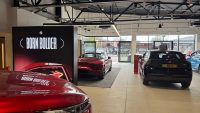 Pricing. It’s key. It’s the thing that matters most to almost all buyers. It’s the digits that attract them and it’s the thing they’ll want to discuss more than anything else when they’re sat in front of you. They’ll want it smaller, you’ll want it higher – and if you’re lucky you’ll meet somewhere in the middle.
Pricing. It’s key. It’s the thing that matters most to almost all buyers. It’s the digits that attract them and it’s the thing they’ll want to discuss more than anything else when they’re sat in front of you. They’ll want it smaller, you’ll want it higher – and if you’re lucky you’ll meet somewhere in the middle.
Pricing is absolutely vital in the car business – it’s a science, an art form, an equation far larger than most of us can even fathom – and it’s something I’ve been thinking long and hard about over the last few weeks.
I’m not talking about used cars. Those prices aren’t so hard for me to understand. Well, not really anyway. I’ve never quite worked out why a car that’s sat around not getting any more miles on it loses value quite as quickly as it does – but I suppose that’s just one of those things.
I sort of understand the mechanics of setting a second-hand car price. You look in the guides, browse the web and see what your competitors are doing, and use some good old-fashioned dealer intuition to work out what digits to slot into that number board.
And if they fail to do the job, you fiddle with them until a buyer is found. That makes sense in my rather fuzzy and in no way mathematical bonce.
 However, the science of pricing NEW cars, well, that just sends my cranium into meltdown. I’ve been pondering this point for some time and I still can’t work it out: Just how do car manufacturers work out what price to set their cars at? Why does a Range Rover cost £100k and a Dacia Sandero cost £6k? How can they be so vastly different? Both manufacturers must be making a margin – albeit with a different number of zeros on the end – but how are those decisions reached?
However, the science of pricing NEW cars, well, that just sends my cranium into meltdown. I’ve been pondering this point for some time and I still can’t work it out: Just how do car manufacturers work out what price to set their cars at? Why does a Range Rover cost £100k and a Dacia Sandero cost £6k? How can they be so vastly different? Both manufacturers must be making a margin – albeit with a different number of zeros on the end – but how are those decisions reached?
Think about it. Before car manufacturers even begin to enter digits into a spreadsheet totting up basic material costs they have all manner of things to account for first.
There’s the research, the engineering, the artists, the concepts, the testing, more testing, crash testing, more concepts, more testing, marketing, publicity, advertising, websites, launches and much more.
Then there’s the tooling at the factory, the power for the factory, the manpower for the factory. All that before we’ve even begun to think about the sum of the actual parts – before that goes anywhere near a bean counter, a supercomputer has to work out how much has been spent already. All of that is an investment that needs to be recouped, outlay considered and documented and taken into account when those new car prices are set.
Then there’s the parts. Just look at a new Range Rover and think for a moment just how many bolts, screws and fixings are needed alone to piece it together.
What on earth do they cost? Then there’s the metal, the leather, the wood, the glass, the wiring, the technology (which needs to be engineered, designed, tested), to be totted up.
How many people work out these sums? Is Stephen Hawking locked away for a year to number-crunch? Is that where Carol Vorderman spends her time when she’s not having work done? I find it hard enough working out how much to charge for my garage tat at a car boot sale, so I can’t even begin to imagine what it’s like for the car manufacturers’ money men.
Then there’s the brand value to consider. It’s part of the reason that the aforementioned Dacia costs 10 times less than a Range Rover, but how do they work out what that’s worth? Algebra?
And then what happens if you’ve done the maths, checked and double-checked the spreadsheet, run it past your board, and then your main competitor launches its luxury SUV for £10,000 less? Do they go back to the drawing board and number-crunch again? Can you see why it makes my head hurt just thinking about it?
But that’s not what really makes me giddy. Oh no. What does is knowing that despite the months spent working out the pricing is mathematically perfect, ensuring the figure makes the right returns for you and your manufacturer, the first thing to come out of the mouth of the punter sat in front of your desk: ‘What’s your best price, mate?’.
Perhaps it might be worth letting them read this first – maybe then they’ll think twice before even asking…
































